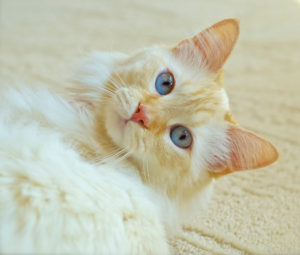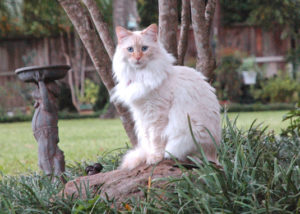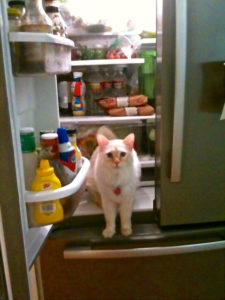Nilla’s Lifelong Battle With Food Aversion

Nilla
Is Your Cat Food Averse?
However strange it may seem, there are cats who are just not into food. It doesn’t matter what you offer or try to bribe them with, they will eat the bare minimum and that’s it. Food aversion in cats can be a very serious thing. In my experience over the past couple of years I’ve learned that this condition can often be related to food and emotional sensitivities. It’s a bit like an allergy without the allergic reaction. With cats being emotional creatures we probably don’t give them enough credit for their ability to associate negative or traumatic experiences with food. We also often fail to understand how long term food sensitivities can lead to serious health conditions.
In fact, cats can even develop anorexia from a prolonged lack of appetite. Often times there is either an underlying disease or an emotional or psychological reason the cat doesn’t want to eat. In an article on the Cornell Feline Health Center web page Carolyn McDaniel, DMD, discusses how challenging and serious this condition can be. “Whatever its cause, anorexia can have a severe impact on a mature cat’s health if it persists for as little as 24 hours. For a kitten younger than six weeks of age, food avoidance for just 12 hours can pose a lethal threat.”

Nilla
Almost a year ago I wrote a post about a sweet kitty named Nilla who disappeared for 61 days in the Colorado wilderness and survived. If you haven’t read that amazing account you can read it here. Nilla has never been a big eater, and when she would eat, it would only be kibble. I suspect there may have been some emotional issues from her rough start as a kitten that may have influenced her lack of interest in food. If you have a cat who struggles with the same issue I’m hoping this story will give you hope. Nilla has an amazing story, and I asked her mom, Lisa, to share it.
Nilla came to our family in 2009, only three and half months before our daughter, Ashley, passed away. Ash was in the hospital at the time, and her best friend was complaining of this new cat she had that was destroying her apartment. Apparently there was a lot of drama involved. Her friend kept trying to convince Ashley to take her but I said no. Our plate was full with Ashley’s illness, Ashley’s three cats and our two dogs. We eventually agreed that her best friend, Lisa, would take the cat to Ashley’ apartment, and I would pick it up and take it to a shelter. When it came time to pick up the little demon I opened the apartment door I couldn’t believe my eyes. In front of me standing on wobbly legs was a 6week old white, blue eyed ball of static fur fluff! She was so tiny she couldn’t even crawl into her potty box!!! Needless to say she was staying with our family. She was so precious and gentle–not a timid kitten–and so easy going!!!
We had a kibble addict!
For the first week she would only drink water and eat some whipped cream. She refused to eat baby food, wet food, kibble and even treats. Slowly I got her to eat Purina (ugh) kitten, and for months she stayed on this. I tried relentlessly to add wet food without success. Months turned into years of the ugly kibble cycle or hard treats. She had such an aversion to wet or soft foods! I would fast her for three days but she always won, and I would cave in. In the summer of 2017 on Father’s Day, high in the mountains of Colorado where we were spending our summer, Nilla escaped. I believe she just went to explore the yard, but it was dusk, and the wild life was active. (We would regularly see fox, coyote, eagles, hawks, snakes, bears, and mountain lions.) I think something frightened her, and she ran from our home. She was gone! We searched for weeks day and night with the help from friends and our dogs. Nothing! Nilla was an indoor cat that only ate kibble. There was no sign of her–good or bad–for miles in the mountains. The weather was not on Nilla’s side; the days were filled with relentless sun, and the nights were chilly. We took out radio and newspaper ads, put up posters, and called shelters. Weeks turned into months, and it was almost time to return to Texas. I couldn’t imagine the thought of one of my family members not returning, but I refused to give up!!!
On the 61st day of her disappearance I got a call from a shelter 32 miles away. ”Did we have a missing cat?” It had been so long since I first alerted them. The girl on the phone thought she matched Nilla’s description but she wasn’t sure. I grabbed my crate and drove about half an hour to this shelter located even further up the mountain. When I arrived they walked me back to a dark office with a set of kennel cages. The cat in the crate wasn’t moving, and its head resting on the floor of the cage. Even when the girl opened the cage there was still no movement. I didn’t know it this was our girl. It was skin and bones, missing fur, and so dirty. I called her name, and she tried so hard to lift her head; she tried to meow, but her meow didn’t come out. The girl turned on the light…it was Nilla! But she was barley alive. She had been trapped by a woman 18 miles away from us. She had watched her for days thinking she was feral. She could tell Nilla was getting weak, yet she would not eat any of the food that she put out. (It was wet food.) She was finally able to catch her after about a week with some treats and immediately took her to the shelter.
Nilla resting at the wildlife rescue center
Nilla was missing hair, had broken teeth, had several nails torn out, was dehydrated, sunburned, had cactus spines stuck in her fur, and sores all over her body. She was down to 6.9 lbs from about 12. Fortunately the vet visit was a good one, but she needed a lot of care. So began her recovery, feeding small amounts of food every four hours. She only wanted kibble, but her mouth had sores and broken teeth. The kibble seemed to hurt her, but stubbornly she tried to eat it. Then I became the wet food/baby food Nazi: she refused! Therefore I force-fed her four times a day whiles my husband held her. I spooned it into her mouth and held it closed until she swallowed. We slowly made progress, and soon it turned into taking food off the spoon herself, and ultimately she would eat out of her bowl all by herself! We were grain free and no kibble! Three weeks later she looked amazing, and we continued to make progress. Eventually I decided to allow some kibble again….big mistake! She was a ‘crack head kibble kitty,” and she was hooked again. She also continued eating the wet food, so I thought it was ok until she developed some tiny sores on her head. We thought it may be due to rough play with other animals in the house, but it wasn’t. Pam did a muscle testing analysis on her (details below) and found a list of issues with her food. The culprit was…kibble and food sensitivities. Today the entire household of cats and dogs are grain and kibble free, and everyone is thriving. Now all the cats are off kibble for the first time ever, and they are acting like kittens again. They are active, sassy, happy, talkative and hungry, and they are clearly all living life again!
Nilla’s Food Sensitivities
A couple months ago Lisa sent me a photo of Nilla with a black sore on her face. (referenced from the story above) At first we thought it may be a scratch from playing with an aggressive puppy. When it grew worse and more spots appeared we realized it was something more serious.  I worked remotely to muscle test Nilla by using her photo to determine what was causing her feline acne and terrible black sores on her face. Usually these symptoms point to food sensitivities, and I was right! Nilla had been eating Acana Wild Atlantic kibble, and while it’s grain free, it’s not carb free. Among the ingredients that her body didn’t like were peas, lentils, pinto beans and chickpeas. She also had sensitivities to duck, tuna, salmon and rabbit along with vomiting and allergies.
I worked remotely to muscle test Nilla by using her photo to determine what was causing her feline acne and terrible black sores on her face. Usually these symptoms point to food sensitivities, and I was right! Nilla had been eating Acana Wild Atlantic kibble, and while it’s grain free, it’s not carb free. Among the ingredients that her body didn’t like were peas, lentils, pinto beans and chickpeas. She also had sensitivities to duck, tuna, salmon and rabbit along with vomiting and allergies.
I used an energy medicine technique called ECR (energetic cellular release) to help Nilla’s body release these energetic cellular memories. Then I recommended Lisa switch her to something besides the proteins she was sensitive to, and lo and behold she “ate the canned turkey cold without even blinking.” She was definitely heading in the right direction! Lisa used a topical colloidal silver gel (by Sovereign Silver) for the sores on Nilla’s head and we started a protocol of milk thistle and a lymphatic support called Lymph Tone 3 by Energetix to help her body detox and cleanse her liver.
About two weeks later she was becoming difficult again at mealtimes and really hated taking the supplements. Muscle testing revealed that she was no longer sensitive to the foods but instead to anxiety, eating and skin disease. ECR was used once more, and days later Lisa reported that Nilla’s appetite was “voracious!” It took a few weeks but her skin finally cleared up, too. Lisa and I both were elated!
 Success is possible!
Success is possible!
Cats with food aversion can be helped to overcome this condition, but it takes a lot of patience and exploration. Work with your vet to rule out a chronic illness or disease. Keep an open, mind and remember that food sensitivities in cats are very real. It reminds me of people who are gluten or lactose intolerant; it can make them miserable when they eat something that has gluten or milk in it. Muscle testing is the quickest and easiest way to determine if a food sensitivity is causing a cat’s lack of appetite. Once you determine what they’re sensitive to it’s easy to explore other food options that would be more appealing. Combine this with ECR and your cat can successfully eat those ingredients again!
If you suspect that your cat may have some food intolerances or is showing signs of feline acne, you can set up an Optimal Cat Health Analysis with Pam remotely. Thank you for sharing this article on your favorite social channels!
Sign up here to follow our blog.


